An unbelievably enormous leatherback sea turtle was discovered on a beach in Spain.
The leatherback was found dead on the shore of Calella, about 36 miles from Barcelona. The large animal was placed in the bed of an industrial truck so it could be driven off the beach, the Daily Mail reported.





